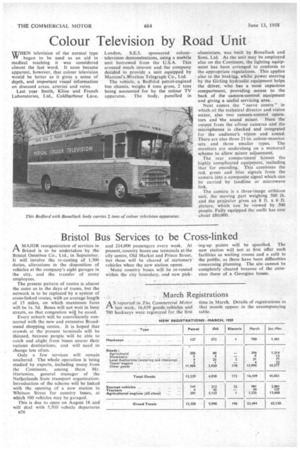Colour Television by Road Unit
Page 60

If you've noticed an error in this article please click here to report it so we can fix it.
'WHEN television of the normal type IN began to be used as an aid in medical teaching it was considered almost the last word. It soon became apparent, however, that colour television would be better as it gives a sense of depth, and important visual information on diseased areas. arteriei and veins.
Last year Smith, Kline and French Laboratories, Ltd., Coldharbour Lane, London, S.E.5, sponsored colourtelevision demonstrations, using a mobile unit borrowed from the U.S.A. This aroused much interest and. the company decided to provide a unit equipped by Marconi's.Wireless Telegraph CO., Ltd.
The vehicle, a Bedfiird petrol-engined bus chassis. weighs 8 tons gross, 2 tons being accounted for by the colour TV apparatus. The body, panelled in
aluminium, was built by Bonallack and Sons, Ltd. As the unit may be employed also on the Continent, the lighting equipment has been arranged to conform to the appropriate regulations. This applies also to the braking, whilst power steering by the Girling hydraulic equipment helps the driver, who has a most capacious compartment, providing access to the back of the camera-control equipment and giving a useful servicing area.
Next comes the " nerve centre" in which sit the technical director and vision mixer, also two camera-control operators and 'the sound mixer. Here the output from the cOlour cameras and the microphones is checked and integrated for the audience's vision and sound. There are also three 21-in, colour-monitor sets and three smaller types. The monitors are underslung on a monorail scheme to allow minor adjustment.
The rear compartment houses the highly complicated equipment, including that for encoding. This combines the red, green and blue signals from the camera into a composite signal which can be carried by landline or microwave link.
The camera is a three-image orthicon unit, the moving part weighing 500 lb. and the projector gives an 8 ft. x 6 ft. picture, which can be viewed by 300 people. Fully equipped the outfit has cost about £80,000.




































































































